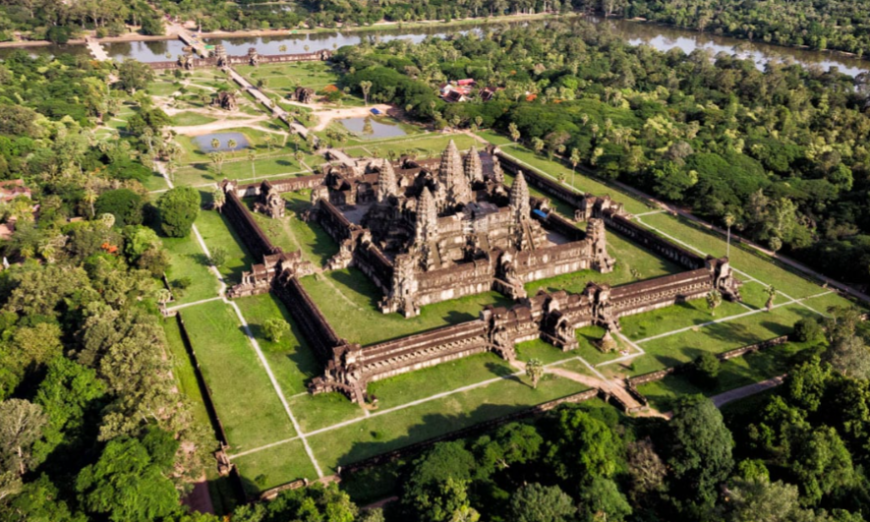The name Angkor is derived from nokor, a Khmer word meaning “kingdom” which in turn is derived from Sanskrit word nagara meaning “city”. The Angkorian period began in AD 802, when the Khmer Hindu monarch Jayavarman II declared himself a “universal monarch” and “god-king”, and lasted until the late 14th century, first falling under Ayutthayan suzerainty in 1351. A Khmer rebellion against Siamese authority resulted in the 1431 sacking of Angkor by Ayutthaya, causing its population to migrate south to Longvek.
The ruins of Angkor are located amid forests and farmland north of the Great Lake (Tonlé Sap) and south of the Kulen Hills, near modern-day Siem Reap city (13°24′N, 103°51′E), in Siem Reap Province.

The temples of the Angkor area are numbering over one thousand, ranging in scale from nondescript piles of brick rubble scattered through rice fields to the Angkor Wat, said to be the world’s largest single religious monument. Many of the temples at Angkor have been restored, and together, they comprise the most significant site of Khmer architecture.
Visitor numericals approach two million annually, and the entire expanse, including Angkor Wat and Angkor Thom is collectively protected as a UNESCO World Heritage Site. The popularity of the site among tourists presents multiple challenges to the preservation of the ruins.
In 2007, an international team of researchers using satellite photographs and other modern techniques concluded that Angkor had been the largest pre-industrial city in the world, with an elaborate infrastructure system connecting an urban sprawl of at least 1,000 square kilometres (390 sq mi) to the well-known temples at its core.
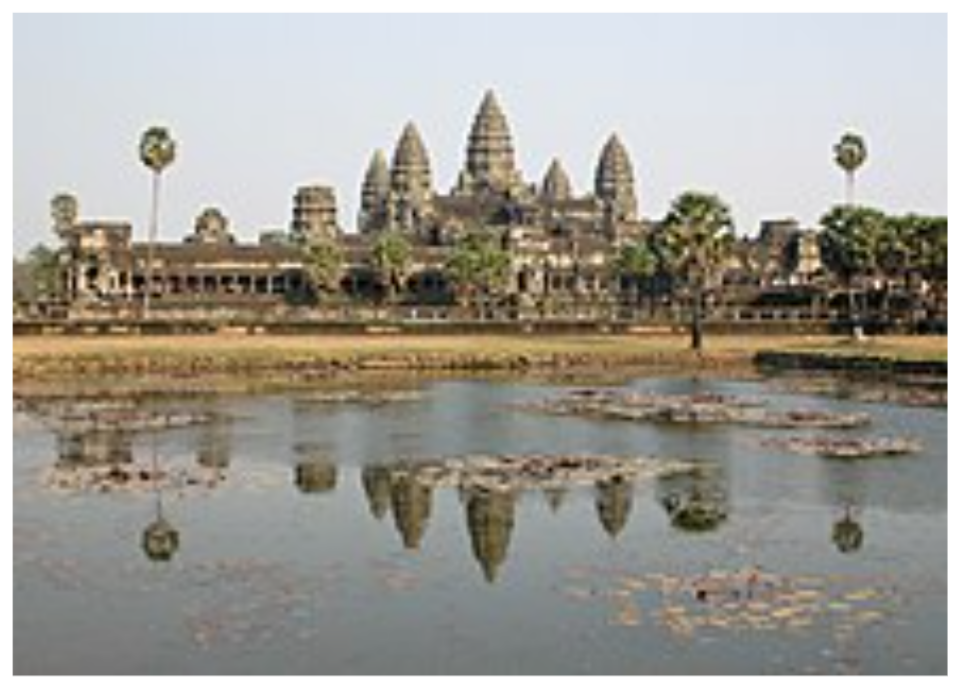
Angkor is considered to be a “hydraulic city” because it had a complicated water management network, which was used for systematically stabilizing, storing, and dispersing water throughout the area.
This network is believed to have been used for irrigation in order to offset the unpredictable monsoon season and to also support the increasing population.
Although the size of its population remains a topic of research and debate, newly identified agricultural systems in the Angkor area may have supported between 750,000 and one million people.
Angkor Wat is a temple complex at Angkor, Cambodia. It is the largest religious monument in the world, on a site measuring 162.6 hectares (1,626,000 m2; 402 acres) which was built by a Khmer king Suryavarman II in the early 12th century as his state temple and capital city.
Though just one of hundreds of surviving temples and structures, the massive Angkor Wat is the most famed of all Cambodia’s temples—it appears on the nation’s flag—and it is revered for good reason. The 12th century “temple-mountain” was built as a spiritual home for the Hindu god Vishnu.26-Sept-2018
Originally dedicated to the Hindu god Vishnu, Angkor Wat became a Buddhist temple by the end of the 12th century. 28-Feb-2018.
Angkor Wat was built by the Khmer King Suryavarman II in the early 12th century in Yaśodharapura (Khmer: យសោធរបុរៈ, present-day Angkor), the capital of the Khmer Empire, as his state temple and eventual mausoleum. Angkor Wat combines two basic plans of Khmer temple architecture: the temple-mountain and the later galleried temple. It is designed to represent Mount Meru, home of the devas in Hindu mythology: within a moat more than 5 kilometres (3 mi) long and an outer wall 3.6 kilometres (2.2 mi) long are three rectangular galleries, each raised above the next. At the centre of the temple stands a quincunx of towers. Unlike most Angkorian temples, Angkor Wat is oriented to the west; scholars are divided as to the significance of this. The temple is admired for the grandeur and harmony of the architecture, its extensive bas-reliefs, and for the numerous devatas adorning its walls.
As the best-preserved temple at the site, Angkor Wat is the only one to have remained a significant religious centre since its foundation. The temple is at the top of the high classical style of Khmer architecture. It is one of the most important pilgrimage sites for Buddhists in Cambodia and around the world, having played a major role in converting Cambodia into a Buddhist nation. It has become a symbol of Cambodia, appearing on its national flag, and is the country’s main tourist attraction.
Angkor Wat lies 5.5 kilometres (3+1⁄2 mi) north of the modern town of Siem Reap, and a short distance south and slightly east of the previous capital, which was centred at Baphuon. In an area of Cambodia where there is an essential group of ancient structures, it is the southernmost of Angkor’s main sites.
According to a myth, the construction of Angkor Wat was ordered by Indra to serve as a palace for his son Precha Ket Mealea. According to the 13th-century Chinese traveller Zhou Daguan, some believed that the temple was constructed in a single night by a divine architect.
The brahmin by the name of Divākarapaṇḍita was responsible for urging King Suryavarman II to construct Angkor Wat. The initial design and construction of the temple took place in the first half of the 12th century, during the reign of Suryavarman II (ruled 1113 – c. 1150).
All of the original religious motifs derived from Hinduism. Breaking from the Shaiva tradition of previous kings, Angkor Wat was instead dedicated to Vishnu. It was built as the king’s state temple and capital city. As neither the foundation stela nor any contemporary inscriptions referring to the temple have been found, its original name is unknown, but it may have been known as “Varah Vishnu-lok” after the presiding deity. Work seems to have ended shortly after the king’s death, leaving some of the bas-relief decoration unfinished. The term Vrah Viṣṇuloka or Parama Viṣṇuloka literally means “The king who has gone to the supreme world of Vishnu”, which refer to Suryavarman II posthumously and intend to venerate his glory and memory.
In 1177, approximately 27 years after the death of Suryavarman II, Angkor was sacked by the Chams, the traditional enemies of the Khmer.
Thereafter the empire was restored by a new king, Jayavarman VII, who established a new capital and state temple (Angkor Thom and the Bayon, respectively), a few kilometers north, dedicated to Buddhism, because the king believed that the Hindu gods had failed him. Angkor Wat was therefore also gradually converted into a Buddhist site, and many Hindu sculptures were replaced by Buddhist art.
Towards the end of the 12th century, Angkor Wat gradually transformed from a Hindu centre of worship to Buddhism, which continues to the present day. Angkor Wat is unusual among the Angkor temples in that although it was largely neglected after the 16th century, it was never completely abandoned. Fourteen inscriptions dated from the 17th century, discovered in the Angkor area, testify to Japanese Buddhist pilgrims that had established small settlements alongside Khmer locals. At that time, the temple was thought by the Japanese visitors to be the famed Jetavana garden of the Buddha, which was originally located in the kingdom of Magadha, India. The best-known inscription tells of Ukondayu Kazufusa, who celebrated the Khmer New Year at Angkor Wat in 1632.
One of the first Western visitors to the temple was António da Madalena, a Portuguese friar who visited in 1586 and said that it “is of such extraordinary construction that it is not possible to describe it with a pen, particularly since it is like no other building in the world. It has towers and decoration and all the refinements which the human genius can conceive of.”
In 1622, The Poem of Angkor Wat composed in Khmer verse describes the beauty of Angkor Wat and creates a legend around the construction of the complex, supposedly a divine castle built for legendary Khmer king Preah Ket Mealea by Hindu god Preah Pisnukar (or Braḥ Bisṇukār, Vishvakarman), as Suryavarman II had already vanished from people’s minds.
In 1860, with the help of French missionary Father Charles-Émile Bouillevaux, the temple was effectively rediscovered by the French naturalist and explorer Henri Mouhot, who popularised the site in the West through the publication of travel notes, in which he wrote,
One of these temples, a rival to that of Solomon, and erected by some ancient Michelangelo, might take an honorable place beside our most beautiful buildings. It is grander than anything left to us by Greece or Rome, and presents a sad contrast to the state of barbarism in which the nation is now plunged.
In 1861 German anthropologist Adolf Bastian undertook a four-year trip to Southeast Asia and his account of this trip, The People of East Asia ran to six volumes. When Bastian finally published the studies and observations during his Journey through Cambodia to Cochinchina in Germany in 1868 – told in detail but uninspiredly, above all without a single one of his drawings of the Angkorian sites, this work hardly made an impression, while everyone was talking about Henri Mouhot’s posthumous work with vivid descriptions of Angkor, Travels in the Central Parts of Indo-China, Siam, Cambodia and Laos, published in 1864 through the Royal Geographical Society.
There were no ordinary dwellings or houses or other signs of settlement, including cooking utensils, weapons, or items of clothing usually found at ancient sites. Instead, there is only evidence of the monuments themselves.
The artistic legacy of Angkor Wat and other Khmer monuments in the Angkor region led directly to France adopting Cambodia as a protectorate on 11 August 1863 and invading Siam to take control of the ruins. This quickly led to Cambodia reclaiming lands in the northwestern corner of the country such as the areas of Siem Reap, Battambang and Sisophon which were under Siamese rule from 1795 to 1907.
Angkor Wat’s aesthetics were on display in the plaster cast museum of Louis Delaporte called musée Indo-chinois which existed in the Parisian Trocadero Palace from c.1880 to the mid-1920s.
The 20th century saw a considerable restoration of Angkor Wat. Gradually teams of laborers and archeologists pushed back the jungle and exposed the expanses of stone, permitting the sun to once again illuminate the dark corners of the temple. Angkor Wat caught the attention and imagination of a wider audience in Europe when the pavilion of French protectorate of Cambodia, as part of French Indochina, recreated the life-size replica of Angkor Wat during Paris Colonial Exposition in 1931.
Cambodia gained independence from France on 9 November 1953 and has controlled Angkor Wat since that time. It is safe to say that from the colonial period onwards until the site’s nomination as UNESCO World Heritage in 1992, this specific temple of Angkor Wat was instrumental in the formation of the modern and gradually globalised concept of built cultural heritage.
Restoration work was interrupted by the Cambodian Civil War and Khmer Rouge control of the country during the 1970s and 1980s, but relatively little damage was done during this period. Camping Khmer Rouge forces used whatever wood remained in the building structures for firewood, and a shoot-out between Khmer Rouge and Vietnamese forces put a few bullet holes in a bas relief. Far more damage was done after the wars, by art thieves working out of Thailand, which, in the late 1980s and early 1990s, claimed almost every head that could be lopped off the structures, including reconstructions.
The temple is a powerful symbol of Cambodia, and is a source of great national pride that has factored into Cambodia’s diplomatic relations with France, the United States, and its neighbour Thailand. A depiction of Angkor Wat has been a part of Cambodian national flags since the introduction of the first version circa 1863. From a larger historical and even transcultural perspective, however, the temple of Angkor Wat did not become a symbol of national pride sui generis but had been inscribed into a larger politico-cultural process of French-colonial heritage production in which the original temple site was presented in French colonial and universal exhibitions in Paris and Marseille between 1889 and 1937.
In December 2015, it was announced that a research team from University of Sydney had found a previously unseen ensemble of buried towers built and demolished during the construction of Angkor Wat, as well as a massive structure of unknown purpose on its south side and wooden fortifications. The findings also include evidence of low-density residential occupation in the region, with a road grid, ponds, and mounds.
These indicate that the temple precinct, bounded by moat and wall, may not have been used exclusively by the priestly elite, as was previously thought. The team used LiDAR, ground-penetrating radar and targeted excavation to map Angkor Wat.

The Bakong is the earliest surviving Temple Mountain at Angkor.
The dominant scheme for the construction of state temples in the Angkorian period was that of the Temple Mountain, an architectural representation of Mount Meru, the home of the gods in Hinduism.
Enclosures represented the mountain chains surrounding Mount Meru, while a moat represented the ocean. The temple itself took shape as a pyramid of several levels, and the home of the gods was represented by the elevated sanctuary at the center of the temple.
The first great temple mountain was the Bakong, a five-level pyramid dedicated in 881 by King Indravarman I. The structure of Bakong took shape of stepped pyramid, popularly identified as temple mountain of early Khmer temple architecture. The striking similarity of the Bakong and Borobudur in Java, going into architectural details such as the gateways and stairs to the upper terraces, strongly suggests that Borobudur might have served as the prototype of Bakong. There must have been exchanges of travelers, if not mission, between Khmer kingdom and the Sailendras in Java. Transmitting to Cambodia not only ideas, but also technical and architectural details of Borobudur, including arched gateways in corbelling method.

Other Khmer temple mountains include Baphuon, Pre Rup, Ta Keo, Koh Ker, the Phimeanakas, and most notably the Phnom Bakheng at Angkor.
According to Charles Higham, “A temple was built for the worship of the ruler, whose essence, if a Saivite, was embodied in a linga… housed in the central sanctuary which served as a temple-mausoleum for the ruler after his death…these central temples also contained shrines dedicated to the royal ancestors and thus became centres of ancestor worship.
Garuda is a divine being that is part man and part bird. He is the lord of birds, the mythological enemy of nāgas, and the battle steed of Vishnu. Depictions of Garuda at Angkor number in the thousands, and though Indian in inspiration exhibit a style that is uniquely Khmer. They may be classified as follows,
As part of a narrative bas relief, Garuda is shown as the battle steed of Vishnu or Krishna, bearing the god on his shoulders, and simultaneously fighting against the god’s enemies. Numerous such images of Garuda may be observed in the outer gallery of Angkor Wat.
Garuda serves as an atlas supporting a superstructure, as in the bas relief at Angkor Wat that depicts heaven and hell. Garudas and stylized mythological lions are the most common atlas figures at Angkor.
Garuda is depicted in the pose of a victor, often dominating a nāga, as in the gigantic relief sculptures on the outer wall of Preah Khan. In this context, Garuda symbolizes the military power of the Khmer kings and their victories over their enemies. Not coincidentally, the city of Preah Khan was built on the site of King Jayavarman VII’s victory over invaders from Champa.
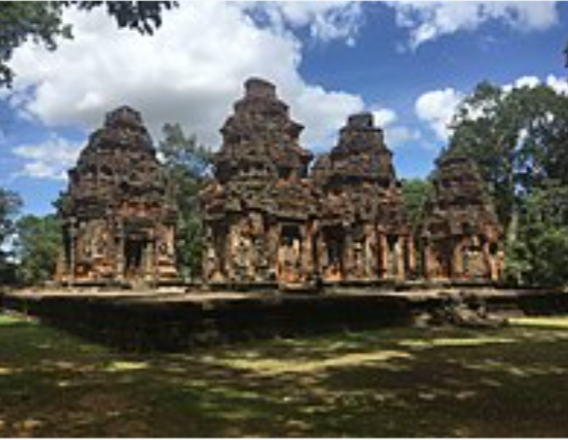
In free-standing nāga sculptures, such as in nāga bridges and balustrades, Garuda is often depicted in relief against the fan of nāga heads. The relationship between Garuda and the nāga heads is ambiguous in these sculptures: it may be one of cooperation, or it may again be one of domination of the nāga by Garuda.
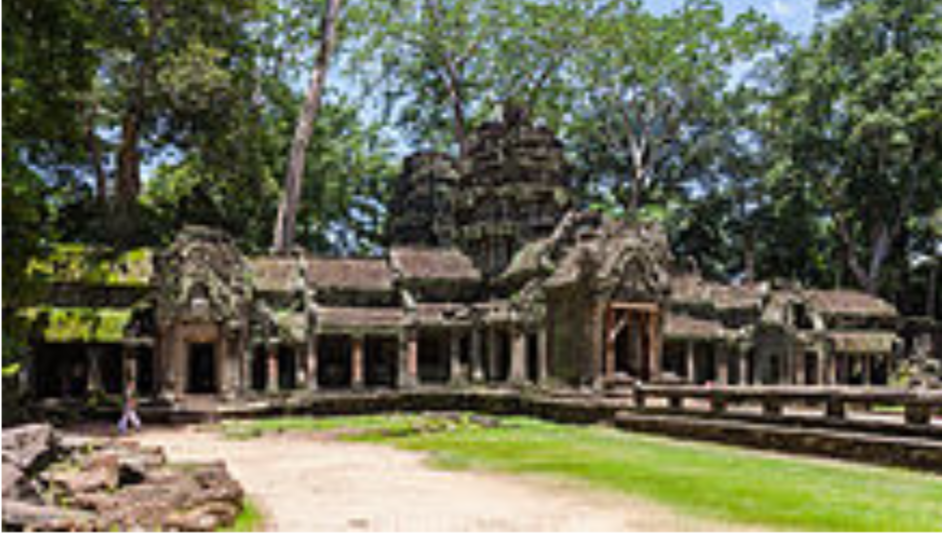
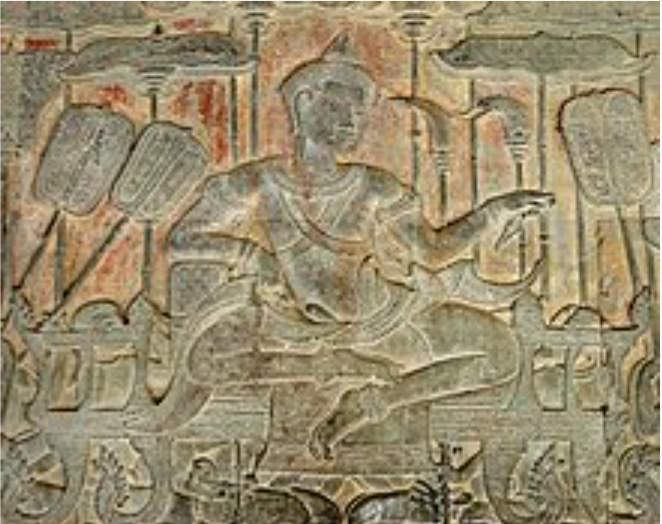
King Suryavarman II is depicted in a bas-relief at Angkor Wat.
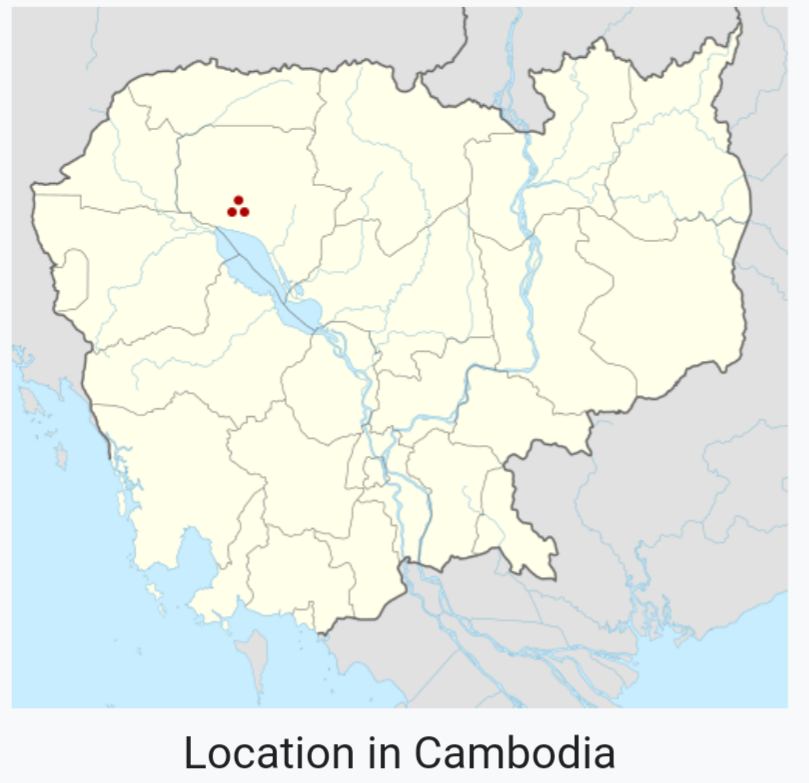
Courtesy, wikipedia.

